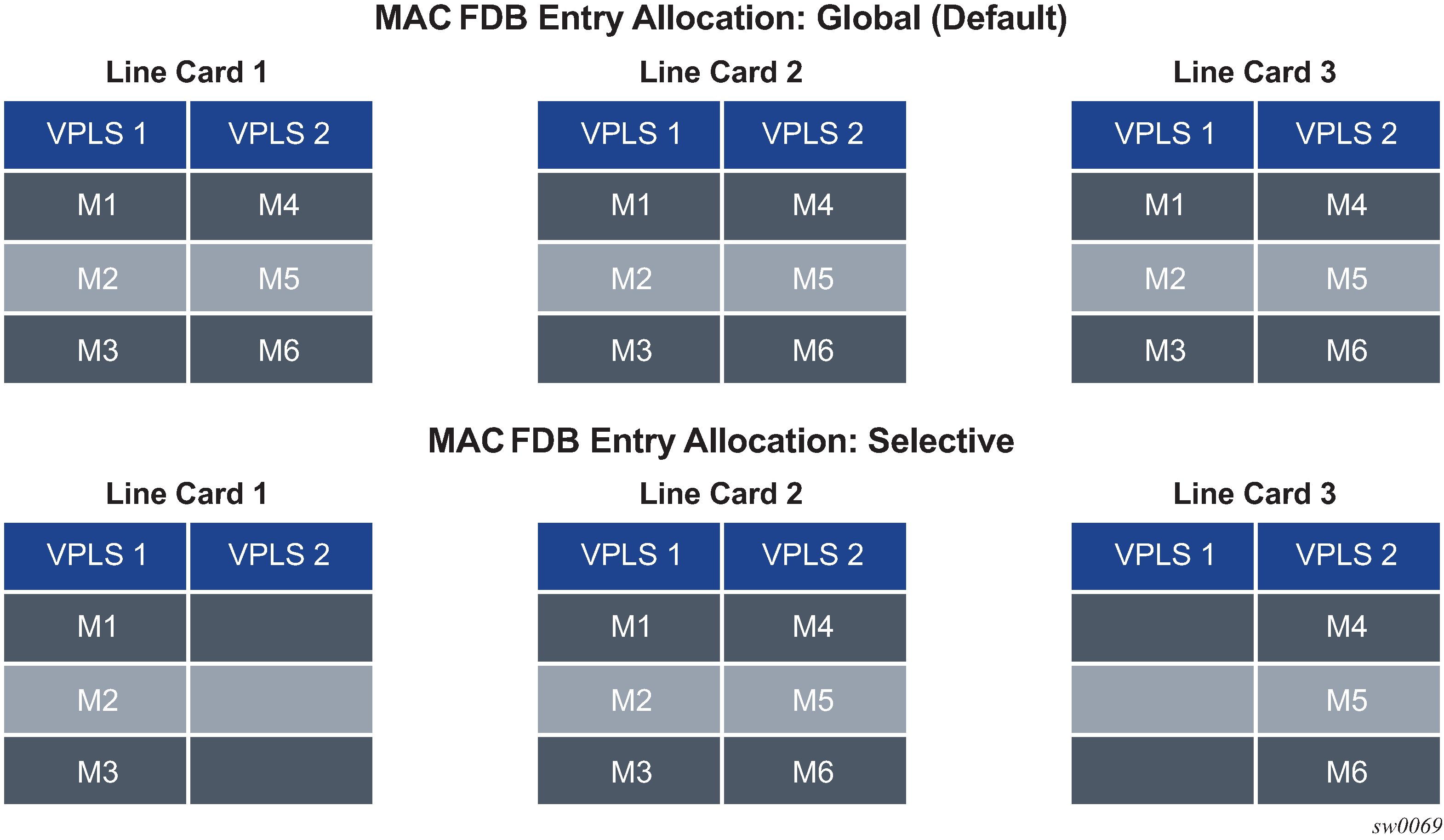Source MAC addresses are learned in a VPLS service by default with an entry allocated in the FDB for each address on all line cards. Therefore, all MAC addresses are considered to be global. This operation can be modified so that the line card allocation of some MAC addresses is selective, based on where the service has a configured object.
An example of the advantage of selective MAC address learning is for services to benefit from the higher MAC address scale of some line cards (particularly for network interfaces used by mesh or spoke-SDPs, EVPN-VXLAN tunnels, and EVPN-MPLS destinations) while using lower MAC address scale cards for the SAPs.
Selective MAC addresses are those learned locally and dynamically in the data path (displayed in the show output with type ‟L”) or by EVPN (displayed in the show output with type ‟Evpn”, excluding those with the sticky bit set, which are displayed with type ‟EvpnS”). An exception is when a MAC address configured as a conditional static MAC address is learned dynamically on an object other than its monitored object; this can be displayed with type ‟L” or ‟Evpn” but is learned as global because of the conditional static MAC configuration.
Selective MAC addresses have FDB entries allocated on line cards where the service has a configured object. When a MAC address is learned, it is allocated an FDB entry on all line cards on which the service has a SAP configured (for LAG or Ethernet tunnel SAPs, the MAC address is allocated an FDB entry on all line cards on which that LAG or Ethernet tunnel has configured ports) and on all line cards that have a network interface port if the service is configured with VXLAN, EVPN-MPLS, or a mesh or spoke-SDP.
When using selective learning in an I-VPLS service, the learned C-MACs are allocated FDB entries on all the line cards where the I-VPLS service has a configured object and on the line cards on which the associated B-VPLS has a configured object. When using selective learning in a VPLS service with allow-ip-intf-bind configured (for it to become an R-VPLS), FDB entries are allocated on all line cards on which there is an IES or VPRN interface.
If a new configured object is added to a service and there are sufficient MAC FDB resources available on the new line cards, the selective MAC addresses present in the service are allocated on the new line cards. Otherwise, if any of the selective MAC addresses currently learned in the service cannot be allocated an FDB entry on the new line cards, those MAC addresses are deleted from all line cards. Such a deletion increments the FailedMacCmplxMapUpdts statistic displayed in the tools dump service vpls-fdb-stats output.
When the set of configured objects changes for a service using selective learning, the system must reallocate its FDB entries accordingly, which can cause FDB entry ‟allocate” or ‟free” operations to become pending temporarily. The pending operations can be displayed using the tools dump service id fdb command.
When a global MAC address is to be learned, there must be a free FDB entry in the service and system FDBs and on all line cards in the system for it to be accepted. When a selective MAC address is to be learned, there must be a free FDB entry in the service and system FDBs and on all line cards where the service has a configured object for it to be accepted.
To demonstrate the selective MAC address learning logic, consider the following:
a system has three line cards: 1, 2, and 3
two VPLS services are configured on the system:
VPLS 1 having learned MAC addresses M1, M2, and M3 and has configured SAPs 1/1/1 and 2/1/1
VPLS 2 having learned MAC addresses M4, M5, and M6 and has configured SAPs 2/1/2 and 3/1/1
This is shown in Table 1.
Learned MAC addresses |
Configured SAPs |
|
|---|---|---|
VPLS1 |
M1, M2, M3 |
SAP 1/1/1 SAP 2/1/1 |
VPLS2 |
M4, M5, M6 |
SAP 2/1/2 SAP 3/1/1 |
Figure 1 shows the FDB entry allocation when the MAC addresses are global and when they are selective. Notice that in the selective case, all MAC addresses are allocated FDB entries on line card 2, but line card 1 and 3 only have FDB entries allocated for services VPLS 1 and VPLS 2, respectively.

Selective MAC address learning can be enabled as follows within any VPLS service, except for B-VPLS and R-VPLS services:
configure
service
vpls <service-id> create
[no] selective-learned-fdb
Enabling selective MAC address learning has no effect on single line card systems.
When selective learning is enabled or disabled in a VPLS service, the system may need to reallocate FDB entries; this can cause temporary pending FDB entry allocate or free operations. The pending operations can be displayed using the tools dump service id fdb command.